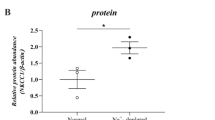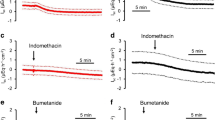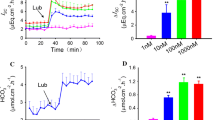Abstract
Recent in vitro studies in human colon have demonstrated marked segmental differences in electrogenic Na transport. In the present study, the Na channel blocker amiloride was used further to characterise basal and aldosterone-induced electrogenic Na transport in isolated human distal and proximal colon. Bathed in NaCl Ringer solution, distal and proximal colon exhibited similar basal electrical properties, but the amiloride-sensitive short-circuit current (I sc) was 200% greater in the distal than in the proximal segment. Bathed in choline-Cl Ringer solution, totalI sc decreased by 97% in distal colon and by 88% in proximal colon, indicating that Na dependent transport process(es) account almost entirely for theI sc in both segments. Substituting Na2SO4 for NaCl Ringer solution (i) increased amiloride-sensitiveI sc by 56% (p<0.01) in distal colon but had no effect on amiloride-sensitiveI sc in proximal colon, and (ii) decreased amiloride-insensitiveI sc in distal and proximal colon by 52% (p<0.05) and 81% (p<0.001) respectively. After the addition of nystatin to the apical membrane, the relationship between totalI sc and mucosal Na concentration indicated that the activity of the basolateral membrane Na pump was similar in both colonic segments. In a further series of experiments, exposure of distal colon to 1 μmol/l aldosterone for 5 h increased totalI sc by 52% (p<0.05), which reflected stimulation of its amiloride-sensitive component; in contrast, aldosterone had no effect on proximal colon. These results indicate that Na-dependent electrogenic processes (with electrogenic Na transport predominant) are present throughout human colon, but there is marked segmental variability in the Na conductive properties of the apical membrane. Apical Na entry in distal colon occurs mainly through ‘classical’ amiloride and aldosterone-sensitive Na channels. In contrast, the predominant apical Na entry mechanism in proximal colon is an amiloride and aldosterone-insensitive path-way.
Similar content being viewed by others
References
Archampong EQ, Harris J, Clark CG (1972) The absorption and secretion of water and electrolytes across the healthy and the diseased human colonic mucosa measured in vitro. Gut 13:880–886
Cass A, Finkelstein A, Krespi V (1970) The ion permeability induced in thin lipid membranes by polyene antibiotics nystatin and amphoptericin B. J Gen Physiol 50:100–124
Clauss W, Schäfer H, Horch I, Hornicke H (1985) Segmental differences in electrical properties and Na-transport of rabbit caecum, proximal and distal colon in vitro. Pflügers Arch 403:278–282
Davis GR, Morawski SG, Santa Ana CA, Fordtran JS (1983) Evaluation of chloride/bicarbonate exchange in the human colon in vivo. J Clin Invest 71:201–207
Edmonds CJ, Richards P (1970) Measurement of rectal electrical potential difference as an instant screening-test for hyperaldosteronism. Lancet 2:624–627
Foster ES, Zimmerman TW, Hayslett JP, Binder HJ (1983) Corticosteroid alteration of active electrolyte transport in rat distal colon. Am J Physiol 245:G668-G675
Foster ES, Budinger ME, Hayslett JP, Binder HJ (1986) Ion transport in proximal colon of the rat. Sodium depletion stimulates neutral sodium chloride absorption. J Clin Invest 77:228–235
Frizzell RA, Schultz SG (1978) Effect of aldosterone on ion transport by rabbit colon in vitro. J Membr Biol 39:1–26
Frizzell RA, Koch MJ, Schultz SG (1976) Ion transport by rabbit colon. I. Active and passive components. J Membr Biol 27:297–316
Fromm M, Hegel U (1978) Segmental heterogeneity of epithelial transport in rat large intestine. Pflügers Arch 378:71–83
Garty H, Edelman IS (1983) Amiloride-sensitive trypsinization of apical sodium channels. Analysis of hormonal regulation of sodium transport in toad bladder. J Gen Physiol 81:785–803
Grady CF, Duhamel RC, Moore EW (1970) Active transport of sodium by human colon in vitro. Gastroenterology 59:585–588
Hawker PC, Mashiter KE, Turnberg LA (1978) Mechanisms of transport of Na, Cl and K in the human colon. Gastroenterology 74:1241–1247
Hill AV (1910) The possible effects of the aggregation of the molecules of haemoglobin on its dissociation curve. J Physiol (Lond) 40:iv-vii
Hubel KA, Renquist K, Shirazi S (1987) Ion transport in human cecum, transverse colon, and sigmoid colon in vitro. Baseline and response to electrical stimulation of intrinsic nerves. Gastroenterology 92:501–507
Koefoed-Johnsen V, Ussing HH (1958) The nature of the frog skin potential. Acta Physiol Scand 42:298–308
Lan NC, Graham B, Bartter FC, Baxter JD (1982) Binding of steroids to mineralocorticoid receptors: implications for in vivo occupancy by glucocorticoids. J Clin Endocrinol Metabol 54: 332–342
Levitan R, Ingelfinger FJ (1965) Effect of d-aldosterone on salt and water absorption from intact human colon. J Clin Invest 44:801–808
Lewis SA, Eaton DC, Diamond JM (1977) Nystatin as a probe for investigating the electrical properties of a tight epithelium. J Gen Physiol 70:427–440
Marusic ET, Hayslett JP, Binder HJ (1981) Corticosteroid-binding studies in cytosol of colonic mucosa in the rat. Am J Physiol 240:G417-G423
Nelson MT, Blaustein MP (1980) Properties of sodium pumps in internally perfused barnacle muscle fibres. J Gen Physiol 75:183–206
Palmer LG, Edelman IS (1981) Control of apical sodium permeability in the toad urinary bladder by aldosterone. Ann NY Acad Sci 372:1–14
Rafestin-Oblin HE, Lombes M, Michel JB, Michaud A, Claire M (1984) Mineralocorticoid receptors in the epithelial cells of human colon and ileum. J Steroid Biochem 20:311–315
Rask-Madsen J, Hjelt K (1977) Effect of amiloride on electrical activity and electrolyte transport in human colon. Scand J Gastroenterol 12:1–6
Sandle GI, McGlone F (1987) Segmental variability of membrane conductances in rat and human colonic epithelia. Implications for Na, K and Cl transport. Pflügers Arch 410:173–180
Sandle GI, Hayslett JP, Binder HJ (1986) The effect of glucocorticoids on rectal transport in normal subjects and patients with ulcerative colitis. Gut 27:309–316
Sandle GI, Wills NK, Alles W, Binder HJ (1986) Electro-physiology of the human colon: evidence of segmental hetero-geneity. Gut 27:999–1005
Schultz SG (1984) A cellular model for active sodium absorption by mammalian colon. Annu Review Physiol 46:435–451
Sellin JH, DeSoignie R (1984) Rabbit proximal colon: a distinct transport epithelium. Am J Physiol 246:G603-G610
Sellin JH, DeSoignie RC (1985) Steroids alter ion transport and absorptive capacity in proximal and distal colon. Am J Physiol 249:G113-G119
Sellin JH, DeSoignie R, (1987) Ion transport in human colon in vitro. Gastroenterology 93:441–448
Turnheim K, Frizzell RA, Schultz SG (1977) Effect of anions on amiloride-sensitive, active sodium transport across rabbit colon, in vitro. J Membr Biol 37:63–84
Turnheim K, Frizzell RA, Schultz SG (1978) Interaction between cell sodium and the amiloride-sensitive sodium entry step in rabbit colon. J Membr Biol 39:233–256
Turnheim K, Thompson SM, Schultz SG (1983) Relation between intracellular sodium and active sodium transport in rabbit colon. J Membr Biol 76:299–309
Wills NK, Lewis SA, Eaton DC (1979) Active and passive properties of rabbit descending colon. A microelectrode and nystatin study. J Membr Biol 45:81–108
Wills NK, Alles WP, Sandle GI, Binder HJ (1984) Apical membrane properties and amiloride binding kinetics of the human descending colon. Am J Physiol 247:G749-G757
Author information
Authors and Affiliations
Rights and permissions
About this article
Cite this article
Sandle, G.I. Segmental heterogeneity of basal and aldosterone-induced electrogenic Na transport in human colon. Pflugers Arch. 414, 706–712 (1989). https://doi.org/10.1007/BF00582139
Received:
Revised:
Accepted:
Issue Date:
DOI: https://doi.org/10.1007/BF00582139




